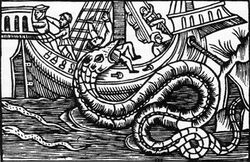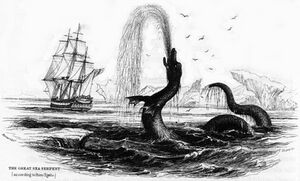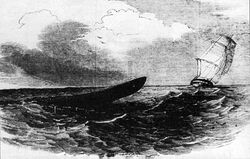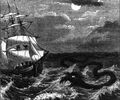Sea serpent
Topic: Unsolved
 From HandWiki - Reading time: 9 min
From HandWiki - Reading time: 9 min
A sea serpent or sea dragon is a type of dragon sea monster described in various mythologies,[1] most notably Mesopotamian (Tiamat), Judaeo-Christian (Leviathan), Greek (Cetus, Echidna, Hydra, Scylla), and Norse (Jörmungandr).
Mythology
Mediterranean and Western Asia
The Drachenkampf mytheme, the chief god in the role of the hero slaying a sea serpent, is widespread both in the ancient Near East and in Indo-European mythology, e.g. Lotan and Hadad, Leviathan and Yahweh, Tiamat and Marduk (see also Labbu, Bašmu, Mušḫuššu), Illuyanka and Tarhunt, Yammu and Baal in the Baal Cycle etc. The Hebrew Bible also has mythological descriptions of large sea creatures as part of creation under Yahweh's command, such as the Tanninim mentioned in Book of Genesis 1:21 and the "great serpent" of Amos 9:3. In the Aeneid, a pair of sea serpents killed Laocoön and his sons when Laocoön argued against bringing the Trojan Horse into Troy. Claudius Aelianus on his work On the Nature of Animals mentions the giant sea centipede which has a tail that is similar to a crayfish and moves through numerous feet on each side of its body.[2] Guillaume Rondelet mentions a similar imaginary creature called centipede cetacean in his work L'histoire entière des poissons.[3]
In antiquity and in the Bible, dragons were envisioned as huge serpentine monsters, with the image of a dragon with two or four legs and wings developing during the Middle Ages. Stories depicting sea-dwelling serpents may include the Babylonian myths of Tiamat, the myths of the Hydra, Scylla, Cetus, and Echidna in Greek mythology, and Christianity's Leviathan.
In Nordic mythology, Jörmungandr (or Midgarðsormr) was a sea serpent or worm so long that it encircled the entire world, Midgard.[4] Sea serpents also appear frequently in later Scandinavian folklore, particularly in that of Norway, such as an account that in 1028 AD, Saint Olaf killed a sea serpent in Valldal in Norway, throwing its body onto the mountain Syltefjellet. Marks on the mountain are associated with the legend.[5][6]
Natural history
An apparent eye-witness account is given by Aristotle in his work Historia Animalium on natural history. Strabo makes reference to an eyewitness account of a dead sea creature sighted by Poseidonius on the coast of the northern Levant. He reports the following: "As for the plains, the first, beginning at the sea, is called Macras, or Macra-Plain. Here, as reported by Poseidonius, was seen the fallen dragon, the corpse of which was about a plethrum [30 m or 100 feet] in length, and so bulky that horsemen standing by it on either side could not see one another, and its jaws were large enough to admit a man on horseback, and each flake of its horny scales exceeded an oblong shield in length."[7] The creature was seen sometime between 130 and 51 BC.
Norway, 16th century
Swedish ecclesiastic and writer Olaus Magnus included illustrations of sea serpents and other various marine monsters on his illustrated map, the Carta marina. In his 1555 work History of the Northern Peoples, Olaus gives the following description of a Norwegian sea serpent:
| “ | Those who sail up along the coast of Norway to trade or to fish, all tell the remarkable story of how a serpent of fearsome size, from 200 feet [60 m] to 400 feet [120 m] long, and 20 feet [6 m] wide, resides in rifts and caves outside Bergen. On bright summer nights this serpent leaves the caves to eat calves, lambs and pigs, or it fares out to the sea and feeds on sea nettles, crabs and similar marine animals. It has ell-long hair hanging from its neck, sharp black scales and flaming red eyes. It attacks vessels, grabs and swallows people, as it lifts itself up like a column from the water.[8][9] | ” |
Norwegian Bishop Erik Pontoppidan (1698–1764) did not disbelieve the existence of sea serpents themselves, but doubted they would prey on ships and feed on humans,[10] being more cautious-minded in that respect than Archbishop Olaus (of Upsala). Nevertheless, a number of reports were made by sailors at the time that sea serpents would destroy ships by wrapping the ship in coils of their body and pulling it underwater. Sailors threatened by a sea serpent were said to have thrown large objects such as paddles or shovels overboard in the path of the serpent, hoping that the serpent would take the object and leave without destroying the ship.[11]
Greenland in 1734
Rev. Hans Egede,[lower-alpha 1] a Dano-Norwegian clergyman who was an early explorer and surveyor of Greenland, gave an 18th-century description of a sea serpent witnessed by his party. In his journal he wrote:[14][15]
On the 6th of July, 1734, there appeared a very large and frightful sea monster, which raised itself so high out of the water that its head reached above our main-top (top of the mainmast). It had a long, sharp snout, and spouted water like a whale; and very broad flappers. The body seemed to be covered with scales, and the skin was uneven and wrinkled, and the lower part was formed like a snake. After some time the creature plunged backwards into the water, and then turned its tail up above the surface, a whole ship-length from the head. The following evening we had very bad weather" ―translated in Henry Lee (1883).[15]
Egede also wrote on the same sea-monster sighting in his book, noting that the beast was spotted at the 64th degree of latitude, and was as thick[16] or "bulky as the Ship, and three or four times as long".[17][18] Egede himself did not supply a sketch in this otherwise well-illustrated book, but the missionary named Bing who was his comrade drew a sketch, which is reproduced in Henry Lee's work.[12]
Bing further described this creature as having reddish eyes, almost burning with fire. This convinced Bishop Pontoppidan that this was different from the type of sea serpent seen by others. From Bing's drawing, Pontoppidan estimated the creature to be considerably shorter than the length of a cable rope, or 100 fathoms (200 m (220 yd)) attested by multiple witnesses, and the pair of fins which were attached "below the waist (Danish: liv)" in Pontoppidan's view, was another unusual feature.[19]
Lee proposed a rational explanation that this sea-serpent was a misapprehended sighting of what was actually the exposed head and one tentacle of a great squid (Cf. figure above left).[20]
New York exhibition in 1845
In 1845, a 35 m (115 ft) long skeleton claimed as belonging to an extinct sea serpent was put on a show in the New York City by Albert C. Koch. The claim was debunked by Prof. Jeffries Wyman, an anatomist who went to see the skeleton for himself. Wyman declared that the skull of the animal had to be mammalian in origin, and that the skeleton was composed of bones of several different animals, including an extinct species of whale.[21]
Portuguese waters, 1848
On 6 August 1848 Captain McQuhae of HMS Daedalus and several of his officers and crew (en route to St Helena) saw a sea serpent which was subsequently reported (and debated) in The Times. The vessel sighted what they named as an enormous serpent between the Cape of Good Hope and St Helena. The serpent was witnessed to have been swimming with 1.2 m (4 feet) of its head above the water and they believed that there was another 18 m (60 feet) of the creature in the sea. Captain McQuahoe also said that "[The creature] passed rapidly, but so close under our lee quarter, that had it been a man of my acquaintance I should have easily have recognized his features with the naked eye." According to seven members of the crew, it remained in view for around twenty minutes. Another officer wrote that the creature was more of a lizard than a serpent. Evolutionary biologist Gary J. Galbreath contends that what the crew of Daedalus saw was a sei whale.[22]
A report was published in the Illustrated London News on 14 April 1849 of a sighting of a sea serpent off the Portuguese coast by HMS Plumper.
On the morning of the 31st December, 1848, in lat. 41° 13'N., and long. 12° 31'W., being nearly due west of Oporto, I saw a long black creature with a sharp head, moving slowly, I should think about two knots [3.7 km/h; 2.3 mph] ... its back was about twenty feet [6 m] if not more above water; and its head, as near as I could judge, from six to eight [1.8 to 2.4 m] ...There was something on its back that appeared like a mane, and, as it moved through the water, kept washing about; but before I could examine it more closely, it was too far astern—"A Naval Officer"[23]
- "A giant snake appeared at once from the water - and the largest cetacean a boa constrictor way wrapped twice. (I note such a physeter It can grow to 20-30 meters long!) It lasted for about 15 minutes the deadly struggle, the sea was just foaming and crashing waves around us, finally the back of the whale stood out Out of the water, he sank head first into the deep where the snake must have killed him. A cold shiver ran through us a cet at the sight of his final struggle; so writhing poor in the monster's double ring, like a little bird between the claws of a falcon. View of the two rings, the snake. It could have been 160-170 feet long and 7-8 feet thick."[11]
Gallery
The first American sea serpent, reported from Cape Ann, Massachusetts , in 1639
Albert Koch's 35-metre-long (115-foot) "Hydrarchos" fossil skeleton from 1845. It was found to be an assembled collection of bones from at least five fossil specimens of Basilosaurus.
Oarfish that washed ashore on a Bermuda beach in 1860. The animal was 5 m (16 feet) long and was originally described as a sea serpent.
In media
- C. S. Lewis's The Chronicles of Narnia features a sea serpent as one of many obstacles in The Voyage of the Dawn Treader, along with the 1989 TV serial and the 2010 film based on it.
- Beany and Cecil, featuring a sea sick sea serpent. Revived as The New Beany and Cecil Show by prouducer DIC Entertainment.
See also
- Bakunawa
- Chinese dragon
- Giant oarfish
- Gyarados
- Kraken
- Lindworm
- Nāga
- Pyrosome
- Selma
- Stronsay Beast
- Ogopogo
- Jörmungandr
- Imugi (Korea)
- Mizuchi (Japan)
Explanatory notes
- ↑ "The Apostle of Greenland"
References
- ↑ "Sea serpent | mythology". https://www.britannica.com/topic/sea-serpent.
- ↑ (in en) Epigrams from the Greek Anthology. Oxford University Press. 26 November 2020. p. 207. ISBN 978-0-19-259688-8. https://books.google.com/books?id=d-MJEAAAQBAJ. Retrieved 13 July 2023.
- ↑ Pilleri, Georg (1969) (in en). Investigations on Cetacea. Hirnanatomisches Institut der Universität. p. 19. https://books.google.com/books?id=Rl0MAQAAIAAJ. Retrieved 13 July 2023.
- ↑ Simek, Rudolf (1993). Dictionary of northern mythology. Cambridge [England]: D.S. Brewer. p. 179. ISBN 0859915131.
- ↑ "Ormen i Syltefjellet". http://loype.kulturminneaaret2009.no/kulturminneloyper/heilag-olav-i-valldal/ormen-i-syltefjellet/image/image_view_fullscreen.
- ↑ "Galleri NOR". Nb.no. July 11, 1934. http://www.nb.no/cgi-bin/galnor/gn_sok.sh?id=147257&skjema=2&fm=4.
- ↑ Strabo. Geography. Book 16, chapter 2, paragraph 17. https://www.perseus.tufts.edu/hopper/text?doc=Perseus:text:1999.01.0239.
- ↑ "Norse Mythology – Jormungandr". Oracle Thinkquest. http://library.thinkquest.org/08aug/01219/Nrsmyth.html?tql-iframe.
- ↑ Stewart, Gail Barbara (2011). Water Monsters. San Diego, California: ReferencePoint Press. p. 13. ISBN 978-1-60152-345-7. https://books.google.com/books?id=AV1ICOJbq4EC&pg=PA13.
- ↑ Oudemans1892, p. 134.
- ↑ 11.0 11.1 Ráth-Végh István: A tengeri kígyó, Móra Ferenc Ifjúsági Könyvkiadó, Budapest, 1980, ISBN 963-11-2161-5
- ↑ 12.0 12.1 Lee (1883), p. 66.
- ↑ "The Great Sea Serpent (according to Hans Egede)". Antique Print & Map Room. 2023. https://antiqueprintmaproom.com/product/the-great-sea-serpent-according-to-hans-egede-james-hope-stewart/.
- ↑ Ramsvig (1902), p. 271.
- ↑ 15.0 15.1 Lee (1883), p. 65.
- ↑ Ramsvig (1902), pp. 271–272.
- ↑ Egede, Hans (1741). "Kap. VI. Hvad Slags Diur, Fiske og Fugle den Grønlandske Søe giver af sig etc. / § Andre Søe-Diur" (in da). Det gamle Grønlands nye perlustration,... Copenhagen: Groth. pp. 47–48. https://books.google.com/books?id=KrRgAAAAcAAJ&pg=PA47. digital copy@National Library Norway. modern typeset reprint, pp. 65–66 (1926) A.W. Brøggers boktrykkeris forlag.
- ↑ Egede, Hans (1745). "Ch. 6. Of the Greenland Sea Animals, and Sea Fowl and Fishes / § Of other Sea Animals". A description of Greenland : Shewing the natural history, situation, boundaries and face of the country, the nature of the soil;... London: Printed for C. Hitch in Pater-noster Row; S. Austen in Newgate-Street; and J. Jackson near St. James's Gate. pp. 85–89. https://books.google.com/books?id=YHJUAAAAcAAJ&pg=PA87. digital copy@National Library Norway.
- ↑ Ramsvig (1902), p. 272.
- ↑ Lee (1883), p. 67.
- ↑ Stein, Gordon (1993). Encyclopedia of hoaxes. Internet Archive. Detroit : Gale Research. pp. 261. ISBN 978-0-8103-8414-9. https://archive.org/details/encyclopediaofho0000stei.
- ↑ "The Daedalus Sea Serpent Solved". Skeptical Inquirer. September–October 2015. https://centerforinquiry.org/news/mystery_of_the_daedalus_sea_serpent_solved_in_skeptical_inquirer/.
- ↑ "Supposed Appearance of the Great Sea Serpent From HMS Plumper Sketched by an Officer On Board". Illustrated London News. April 14, 1849. https://www.britishnewspaperarchive.co.uk/search/results/1849-04-14?NewspaperTitle=Illustrated%2BLondon%2BNews&IssueId=BL%2F0001578%2F18490414%2F&County=London%2C%20England.
- Bibliography
- Oudemans, A. C. (1892). The Great Sea-serpent: An Historical and Critical Treatise. 1. Lackerbauer, P[ierre] (illustr.). Leiden: E.J. Brill. https://books.google.com/books?id=SERnAAAAcAAJ&pg=PA414.
- Lee, Henry (1883), "The Great Sea Serpent", Sea Monsters Unmasked, The Fisheries Exhibition Literature 3 (London: William Clowes and Sons): pp. 52–103, https://books.google.com/books?id=i3cFAAAAMAAJ&pg=PA52
- Ramsvig, S. A. (July–December 1902). "Sjø-ormens historie: Beretninger om dette hav-uhyres tilsynekomst". Kringsjaa 20: 267-275. https://books.google.com/books?id=6MUCAAAAIAAJ&pg=PA649.
- (Further reading)
- Lyons, Sherrie Lynne (2010). Species, Serpents, Spirits, and Skulls: Science at the Margins in the Victorian Age. State University of New York Press. ISBN 978-1-4384-2802-4.
External links
- Video of the oarfish, a creature that possibly inspired the sea serpent mythology.
- https://emergencemagazine.org/essay/great-sea-serpent/
- https://www.gutenberg.org/files/36677/36677-h/36677-h.htm
 |
 KSF
KSF

















